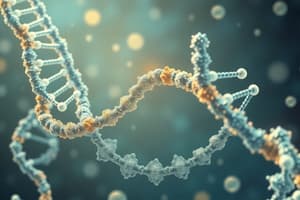Podcast
Questions and Answers
Where is urate fully reabsorbed in the kidney?
Where is urate fully reabsorbed in the kidney?
- Glomerulus
- Collecting duct
- Proximal tubule (correct)
- Distal tubule
What is the primary cause of primary gout?
What is the primary cause of primary gout?
- Chronic hemolytic anemia
- Pernicious anemia
- Defected in synthesis or excretion of urate (correct)
- Increased production of urate
What is the end product of pyrimidine catabolism?
What is the end product of pyrimidine catabolism?
- Glucose-6-phosphate
- Urate
- PRPP
- Beta-amino acids, ammonia, and carbon dioxide (correct)
What is the process by which excess ammonia is removed from the body?
What is the process by which excess ammonia is removed from the body?
What is the condition characterized by a deficiency in Glucose-6-phosphatase?
What is the condition characterized by a deficiency in Glucose-6-phosphatase?
What is the result of increased cell breakdown in certain diseases?
What is the result of increased cell breakdown in certain diseases?
What is the function of purine and pyrimidine in cells?
What is the function of purine and pyrimidine in cells?
What is the difference between purine and pyrimidine?
What is the difference between purine and pyrimidine?
What is the role of nucleotides in nucleic acids?
What is the role of nucleotides in nucleic acids?
What is the purpose of hydrogen bonds in DNA?
What is the purpose of hydrogen bonds in DNA?
Why are purine and pyrimidine nucleotides important?
Why are purine and pyrimidine nucleotides important?
What is the role of ATP in the body?
What is the role of ATP in the body?
What is the consequence of an increased urate in the body?
What is the consequence of an increased urate in the body?
Why do humans have higher uric acid levels?
Why do humans have higher uric acid levels?
Flashcards
Purines and Pyrimidines
Purines and Pyrimidines
Nitrogenous bases forming nucleotide bases in DNA and RNA.
Purines
Purines
Two-carbon nitrogen ring bases (Adenine and Guanine).
Pyrimidines
Pyrimidines
One-carbon nitrogen ring bases (Thymine, Cytosine, and Uracil in RNA).
Nucleotides
Nucleotides
Signup and view all the flashcards
Nucleic Acids
Nucleic Acids
Signup and view all the flashcards
Double Helix Bonds
Double Helix Bonds
Signup and view all the flashcards
ATP, GTP, UTP, CTP
ATP, GTP, UTP, CTP
Signup and view all the flashcards
Gout
Gout
Signup and view all the flashcards
Uricase Deficiency
Uricase Deficiency
Signup and view all the flashcards
Primary Gout Causes
Primary Gout Causes
Signup and view all the flashcards
Secondary Gout Causes
Secondary Gout Causes
Signup and view all the flashcards
Secondary Gout: Increased Turnover
Secondary Gout: Increased Turnover
Signup and view all the flashcards
Pyrimidine Catabolism Products
Pyrimidine Catabolism Products
Signup and view all the flashcards
Urea Cycle (Ornithine Cycle)
Urea Cycle (Ornithine Cycle)
Signup and view all the flashcards
Study Notes
Purine and Pyrimidine
- Purine and pyrimidine are nitrogenous bases that make up the two different kinds of nucleotide bases in DNA and RNA.
- The two-carbon nitrogen ring bases are purines (adenine and guanine), while the one-carbon nitrogen ring bases are pyrimidines (thymine and cytosine).
- Both purines and pyrimidines serve as a form of energy for cells, and are essential for production of DNA and RNA, proteins, starch, regulation of enzymes, and cell signaling.
Biological Function
- Nucleotides are building blocks of nucleic acids (DNA and RNA).
- A nucleic acid contains a chain of nucleotides linked together with covalent bonds to form a sugar-phosphate backbone with protruding nitrogenous bases.
- The two chains in the double helix are held together along their length by hydrogen bonds that form between the bases on one chain and the bases on the other.
Nucleosides and Phosphate Group Bearing Nucleotides
- One of the important specialized pathways of a number of amino acids is the synthesis of purine and pyrimidine nucleotides.
- These nucleotides are important for a number of reasons, including being sources of energy that drive most of our reactions.
- ATP, GTP, UTP, and CTP are nucleotides used in various cellular processes, such as protein synthesis, glucose activation, and lipid metabolism.
Gout
- Gout is a disease characterized by an increased urate in the body, leading to urate deposits in joints.
- Humans lack uricase, which is why their uric acid levels are higher.
- In the kidney, urate is filtered at the glomerulus and fully reabsorbed in the proximal tubule.
- Gout is classified as primary or secondary, depending on the cause of increased urate levels.
Primary and Secondary Gout
- Primary gout is caused by:
- Defects in synthesis or excretion of urate, often due to an enzyme called PRPP.
- Hereditary or genetic conditions, such as glucose-6-phosphatase deficiency.
- Secondary gout is caused by:
- Increased production of urate or impaired excretion of urate as a result of other diseases.
- Increased turnover from increased cell breakdown in diseases such as polycythemia, leukemia, pernicious anemia, chronic hemolytic anemia, and lymphosarcoma.
Pyrimidine Catabolism
- Pyrimidines undergo ring cleavage, and the usual end products of catabolism are beta-amino acids, plus ammonia and carbon dioxide.
- Pyrimidines from nucleic acids or the energy pool are acted upon by nucleotidases and pyrimidine nucleoside phosphorylase to yield the free bases.
- The 4-amino group of both cytosine and 5-methyl cytosine is released as ammonia, which is a toxic product of nitrogen metabolism.
- The urea cycle or ornithine cycle converts excess ammonia into urea in the mitochondria of liver cells, which is then excreted in the urine.
Studying That Suits You
Use AI to generate personalized quizzes and flashcards to suit your learning preferences.




